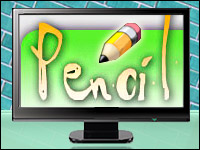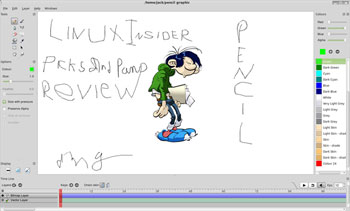
![]()
Pencil is an advanced drawing and animation tool that creates traditional, hand-drawn 2D animations and static sketches. Think of this animation/drawing application as an Etch A Sketch with colored sand on steroids.
Pencil creates both bitmap and vector images. Finished animations can be exported as a PNG image. Animated sketches can be exported in several handy Flash or Movie file formats.
Pencil is a very impressive drawing tool. It imitates hand-drawn animation techniques, is easy to use and produces high-quality output. However, getting it installed was no easy task.
This particular open source project does not appear to be actively supported. Its current version, 0.4.4b, is a beta package released on January 21, 2008. Despite that, it is very stable and usable.
Steady Hand
Trying to do justice to the hand-drawn images for which Pencil is capable is a fool’s errand, at least for me. I can only assess the performance of this software. I lack the artistic skills required to produce sketches by moving the mouse pointer around Pencil’s virtual canvas.
Don’t think so? Take a gander at my hand-crafted letters scratched around the image drawn by the developer and imported into a Pencil frame I created for this review.
Clearly, a talented hand created the multicolored cartoon image. My rickety hand added the pencil scratchings to form a new single image.
Regardless of my personal lack of sketching skills, Pencil has functionality far beyond the tools in simple computerized drawing applications. Its tool set includes the ability to add multiple layers for bitmap, vector, sound and camera.
Daunting Downloads
Sometimes reviewing Linux software can involve high intrigue and mystery. That was the case in tracking down and installing this software.
Several websites host packages bearing the Pencil name or something very similar. Not all were the same software, and some versions of the intended package failed to install.
For example, when I first began my quest for an advanced hand-drawn animation package, I found Pencil Animation references and tracked it down to the les-stooges.org web site. I also found the same program — based on displayed screenshots — at the Sourceforge web site here. Other searches led me to the Pencil-Animation.org web site that seemed to have similar, if not the same Linux packages.
Then I found the Pencil Project. This web site asserts that it has the latest version of Pencil — 2.0.3 offered in packages for Fedora and Arch Linux (RPM format) as well as Linux Debian strains (.DEB format). It is listed as the open source GUI prototyping tool for GNU/Linux, Windows and Mac.
While the screenshots were similar, the feature sets were not. It was not the same Pencil project as the beta software I ultimately sought and finally tested.
Inane Installation
Initially, the two web sites for the Pencil Animation package I sought were clearly distinct locations, not mirror sites. The downloadable Pencil package, though named the same, did not install from one of them. When I doubled back more recently to recheck the anomalies, both URLs brought me to the same web site — Pencil-animation.org
Both web sites display a link to Sourceforge.net for a mirror download of Pencil-Animation. Only the package on Sourceforge.net, which bears the identical file name, failed to install due to unresolved dependency issues. Depending on the computer hosting the installation, the developer’s Pencil-Animation.org download produced the same failed results.
The .deb package installer reported that the Libming0 library was not available. Yet the only related library I could find from numerous software repositories was Libming1. However, this library was already installed on the three computers on which I attempted the installation. The installation program did not recognize it and stopped.
Software Solution
The only way I could solve the problem was to install the Pencil package I originally downloaded from the les-stooges site. The package on the Sourceforge and Pencil-animation.org sites had the dependency issue. After these two sites linked to the same location, that problem persisted on some of my subsequent installation attempts.
The version available in the Ubuntu and the Linux Mint software centers initially had the same dependency issues. The package in both of those locations is called Pencil, so don’t look for it as Pencil-Animation even though it is called that elsewhere.
When I doubled back and tried to install Pencil several days later, the Ubuntu and Linux Mint software centers completed the installation on some but not all of my test attempts.
Convenient Canvas
The user interface has a familiar look and feel to it. It you have used any of the common drawing applications, Pencil’s appearance fits right in. You can grab the mouse and start creating cartoon characters, doodles of all sorts and even letters and numbers to augment your sketch.
Pencil excels in what else you can do with it. However, this is the part of the app that requires practice and skill. Creating cartoon scenes with the mouse to drive the pencil point separates the wannabe from the accomplished user.
There is an incomplete user document available here that provides some useful directions on how to use the layering tools and various drawing tools. But this unfinished document (linked from the current version of Pencil’s Help menu) was written for version 0.4.3 on July 21, 2007.
The drawing canvas is in the center of the app window. Along the left side of the window are groups of icons for drawing tools and other display options. Down the right edge of the app window are the color palates and slide bars for saturation levels. Along the bottom of the app window are controls for layering options, sound and animation playback.
Artistic Tools
Pencil comes with a collection of built-in shapes for different drawing purposes. These include general-purpose shapes, flowchart elements and much more.
Pencil also supports connectors which can be used to wire shapes together in a diagram. It includes a collection of flowchart shapes for drawing diagrams.
Whether creating a single caricature or a moving scene, you can incorporate multiple layers. Each layer can be either bitmap or vector format.
There is one proviso, however. A vector layer here means that the layer is drawn with vector curves. Pencil does not incorporate vector animation as in Adobe Flash or the free Synfig animation studio.
Animating Animation
The biggest strength in this nearly abandoned project is the focus on creating hand-drawn 2D animation. A timeline control at the bottom of the screen makes it simple to step through individual frames.
To create an animated sequence, draw on each individual frame as if it were a single animation cell. The program itself maintains consistency between frames by using the onion skin feature. This renders adjacent frames semi-transparently, as if you were drawing on tracing paper.
Step through the frames or run through entire the sequence with built-in playback controls. During playback you can loop the animation and adjust the frame rate as desired.
Bottom Line
If you while away the hours doodling on paper with a pencil, this well-designed application is ideal. Use it to draw at any scale and to any size. Its cross-platform design allows you to use it in most Linux distros as well as on the Windows and Mac platforms.
Pencil was a promising Linux package when it was still in its infancy. However, with this well-oiled beta version now five years old, it is doubtful that developers Pascal Naidon and Patrick Corrieri will move the project along.
Want to Suggest a Linux Application for Review?
Is there a Linux software application you’d like to suggest for review? Something you love or would like to get to know?
Please send your ideas to me at [email protected], and I’ll consider them for a future Linux Picks and Pans column.
And use the Talkback feature below to add your comments!





















































